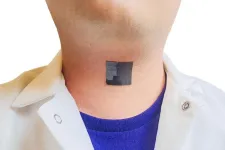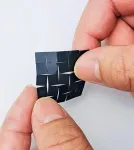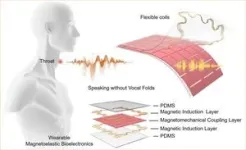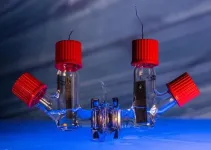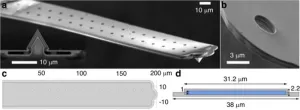(Press-News.org) People with voice disorders, including those with pathological vocal cord conditions or who are recovering from laryngeal cancer surgeries, can often find it difficult or impossible to speak. That may soon change.
A team of UCLA engineers has invented a soft, thin, stretchy device measuring just over 1 square inch that can be attached to the skin outside the throat to help people with dysfunctional vocal cords regain their voice function. Their advance is detailed this week in the journal Nature Communications.
The new bioelectric system, developed by Jun Chen, an assistant professor of bioengineering at the UCLA Samueli School of Engineering, and his colleagues, is able to detect movement in a person’s larynx muscles and translate those signals into audible speech with the assistance of machine-learning technology — with nearly 95% accuracy.
The breakthrough is the latest in Chen’s efforts to help those with disabilities. His team previously developed a wearable glove capable of translating American Sign Language into English speech in real time to help users of ASL communicate with those who don’t know how to sign.
The tiny new patch-like device is made up of two components. One, a self-powered sensing component, detects and converts signals generated by muscle movements into high-fidelity, analyzable electrical signals; these electrical signals are then translated into speech signals using a machine-learning algorithm. The other, an actuation component, turns those speech signals into the desired voice expression.
The two components each contain two layers: a layer of biocompatible silicone compound polydimethylsiloxane, or PDMS, with elastic properties, and a magnetic induction layer made of copper induction coils. Sandwiched between the two components is a fifth layer containing PDMS mixed with micromagnets, which generates a magnetic field.
Utilizing a soft magnetoelastic sensing mechanism developed by Chen’s team in 2021, the device is capable of detecting changes in the magnetic field when it is altered as a result of mechanical forces — in this case, the movement of laryngeal muscles. The embedded serpentine induction coils in the magnetoelastic layers help generate high-fidelity electrical signals for sensing purposes.
Measuring 1.2 inches on each side, the device weighs about 7 grams and is just 0.06 inch thick. With double-sided biocompatible tape, it can easily adhere to an individual’s throat near the location of the vocal cords and can be reused by reapplying tape as needed.
Voice disorders are prevalent across all ages and demographic groups; research has shown that nearly 30% of people will experience at least one such disorder in their lifetime. Yet with therapeutic approaches, such as surgical interventions and voice therapy, voice recovery can stretch from three months to a year, with some invasive techniques requiring a significant period of mandatory postoperative voice rest.
“Existing solutions such as handheld electro-larynx devices and tracheoesophageal- puncture procedures can be inconvenient, invasive or uncomfortable,” said Chen who leads the Wearable Bioelectronics Research Group at UCLA, and has been named one the world’s most highly cited researchers five years in a row. “This new device presents a wearable, non-invasive option capable of assisting patients in communicating during the period before treatment and during the post-treatment recovery period for voice disorders.”
How machine learning enables the wearable tech
In their experiments, the researchers tested the wearable technology on eight healthy adults. They collected data on laryngeal muscle movement and used a machine-learning algorithm to correlate the resulting signals to certain words. They then selected a corresponding output voice signal through the device’s actuation component.
The research team demonstrated the system’s accuracy by having the participants pronounce five sentences — both aloud and voicelessly — including “Hi, Rachel, how are you doing today?” and “I love you!”
The overall prediction accuracy of the model was 94.68%, with the participants’ voice signal amplified by the actuation component, demonstrating that the sensing mechanism recognized their laryngeal movement signal and matched the corresponding sentence the participants wished to say.
Going forward, the research team plans to continue enlarging the vocabulary of the device through machine learning and to test it in people with speech disorders.
Other authors of the paper are UCLA Samueli graduate students Ziyuan Che, Chrystal Duan, Xiao Wan, Jing Xu and Tianqi Zheng — all members of Chen’s lab.
The research was funded by the National Institutes of Health, the U.S. Office of Naval Research, the American Heart Association, Brain & Behavior Research Foundation, the UCLA Clinical and Translational Science Institute, and the UCLA Samueli School of Engineering.
END
Speaking without vocal cords, thanks to a new AI-assisted wearable device
The adhesive neck patch is the latest advance by UCLA bioengineers in speech technology for people with disabilities
2024-03-15
ELSE PRESS RELEASES FROM THIS DATE:
Rice breakthrough could make automated dosing systems universal
2024-03-15
by Jade Boyd
Special to Rice News
HOUSTON – (March 15, 2024) – Rice University synthetic biologists have found a way to piggyback on the glucose monitoring technology used in automated insulin dosing systems and make it universally applicable for the monitoring and dosing of virtually any drug.
In a recently published study in Nature Communications, researchers in the lab of Caroline Ajo-Franklin demonstrated the technique by modifying a blood-glucose sensor to detect the anticancer drug afimoxifene ...
UTA students earn transformative D.C. fellowships
2024-03-15
Seven undergraduate students from The University of Texas at Arlington headed to Washington, D.C., for a hands-on program to live, learn and intern in the nation’s capital.
Founded in 2001, The Archer Center is the Washington, D.C., campus of the University of Texas System. Students accepted to its Archer Fellowship Program move to the Capitol Hill area of Washington to live with other Archer Fellows and take courses taught by UT faculty and policy experts. The scholars also participate in a ...
Why some newborns develop severe infections
2024-03-15
NEW YORK, NY (March 15, 2024)--Compared to adults, newborns are highly susceptible to infections and these infections can cause serious health complications and even death.
One factor known to affect a newborn’s response to infection is a condition called neonatal neutropenia, in which the infant fails to make enough neutrophils, the immune system’s first responders. What underlies this immune deficiency, which greatly increases a newborn’s susceptibility to infection, is largely unknown, leaving clinicians with little understanding of how to prevent or treat it.
A new study of mice by Columbia University ...
Protein fragments ID two new “extremophile” microbes—and may help find alien life
2024-03-15
Perfectly adapted microorganisms live in extreme environments from deep-sea trenches to mountaintops. Learning more about how these extremophiles survive in hostile conditions could inform scientists about life on Earth and potential life on other planets. In ACS’ Journal of Proteome Research, researchers detail a method for more accurate extremophile identification based on protein fragments instead of genetic material. The study identified two new hardy bacteria from high-altitude lakes in Chile — an ...
Plasma oscillations propel breakthroughs in fusion energy
2024-03-15
Most people know about solids, liquids, and gases as the main three states of matter, but a fourth state of matter exists as well. Plasma—also known as ionized gas—is the most abundant, observable form of matter in our universe, found in the sun and other celestial bodies.
Creating the hot mix of freely moving electrons and ions that compose a plasma often requires extreme pressures or temperatures. In these extreme conditions, researchers continue to uncover the unexpected ways that plasma can move and evolve. By better understanding the motion of plasma, scientists gain valuable insights into solar physics, astrophysics, ...
Specialized nursing facility clinicians improve end-of-life care
2024-03-15
Specialized nursing facility clinicians, or SNFists, may decrease the likelihood of nursing home residents experiencing stressful hospitalizations and improve the quality of life in their last days, according to researchers from Weill Cornell Medicine.
The paper, published in JAMA Network Open on Mar. 15, examined how SNFists uniquely impacted the care of nursing home residents in their last 90 days, compared with those cared for by other clinicians. This large-scale study is the first of its kind.
“The literature has described ...
Fatty food before surgery may impair memory in old, young adults
2024-03-15
COLUMBUS, Ohio – Eating fatty food in the days leading up to surgery may prompt a heightened inflammatory response in the brain that interferes for weeks with memory-related cognitive function in older adults – and, new research in animals suggests, even in young adults.
The study, building upon previous research from the same lab at The Ohio State University, also showed that taking a DHA omega-3 fatty acid supplement for a month before the unhealthy eating and surgical procedure prevented the effects on memory linked to both the high-fat diet and the surgery in aged ...
Newly discovered receptor influences gut development in fruit flies
2024-03-15
Adhesion GPCRs belong to the large family of G protein-coupled receptors (GPCRs). There are about 700 variants in humans, which are responsible for sensory impressions, hormonal cycles, controlling the cardiovascular system and more. GPCRs translate stimuli that hit a cell from outside into an intracellular biochemical signal.
The use of the fruit fly as a model animal allows researchers in this field to gain a deep understanding of human diseases, because the animals are genetically very similar to humans. Scientists estimate that around 75 per cent of the genes involved in human diseases ...
New research suggests that our universe has no dark matter
2024-03-15
The current theoretical model for the composition of the universe is that it’s made of ‘normal matter,’ ‘dark energy’ and ‘dark matter.’ A new uOttawa study challenges this.
A University of Ottawa study published today challenges the current model of the universe by showing that, in fact, it has no room for dark matter.
In cosmology, the term “dark matter” describes all that appears not to interact with light or the electromagnetic field, or that can only be explained through gravitational force. We can’t see it, nor do we know what ...
A breakthrough in tiny tool tuning: making microscopic measurements more accurate
2024-03-15
A study introduces a novel method for calibrating the spring constant of FluidFM micropipette cantilevers, crucial for the accurate measurement of forces in microfluidic environments. This method addresses the limitations of current calibration techniques, offering a significant advancement in the field of force microscopy.
Fluidic force microscopy (FluidFM) combines the sensitivity of atomic force microscopy with microfluidics' capabilities, necessitating precise calibration of its cantilevers for reliable data. Traditional methods, however, struggle with the unique internal structure of FluidFM cantilevers, leading to ...
LAST 30 PRESS RELEASES:
General intelligence framework to predict virus adaptation based on a genome language model
Antibiotic resistance is ancient, ecological, and deeply connected to human activity, new review shows
Vapes, pouches, heated tobacco, shisha, cigarettes: nicotine in all forms is toxic to the heart and blood vessels
From powder to planet: University of Modena engineers forge a low-carbon future for advanced metal manufacturing
Super strain-resistant superconductors
Pre-school health programme does not improve children’s diet or physical activity, prompting call for policy changes, study finds
Autumn clock change linked to reduction in certain health conditions
AI images of doctors can exaggerate and reinforce existing stereotypes
Where medicine meets melody – how lullabies help babies and parents in intensive care
We may never be able to tell if AI becomes conscious, argues philosopher
AI video translation shows promise but humans still hold the edge
Deep ocean earthquakes drive Southern Ocean’s massive phytoplankton blooms, study finds
Without campus leftovers to pick through, the beaks of this bird changed shape during the pandemic
High-dose antibiotic does not reduce mortality in tuberculous meningitis
How many insects fly in the sky above the USA?
Could cheese protect your brain health?
Who faces more difficulty recovering from stroke?
Colliding galaxies create the brightest, fastest growing black holes at their center
New BrainHealth research reveals tradeoffs on sleep with cannabis use for chronic pain
Aging-US now on ResearchGate, enhancing visibility for authors and readers
'Molecular glue' stabilizes protein that inhibits development of non-small cell lung cancer
Mount Sinai Health System is recognized in 2025 Chime Digital Health Most Wired survey
From prey to predator: How carnivores spread beneficial fungi
Menopause symptoms may be frequent and have negative effects, according to female endurance athletes
US Congressmembers’ responses on X to mass shooting events differ along party lines
KAIST-UEL team develops “origami” airless wheel to explore lunar caves
Individual genetic differences render some therapies ineffective
Engineering dendritic cells boosts cancer immunotherapy
Sophisticated neuroimaging reveals PTSD in WTC responders is linked to measurable physical changes in brain structure
Health policy experts identify promising strategies for providing health care to homeless people
[Press-News.org] Speaking without vocal cords, thanks to a new AI-assisted wearable deviceThe adhesive neck patch is the latest advance by UCLA bioengineers in speech technology for people with disabilities
